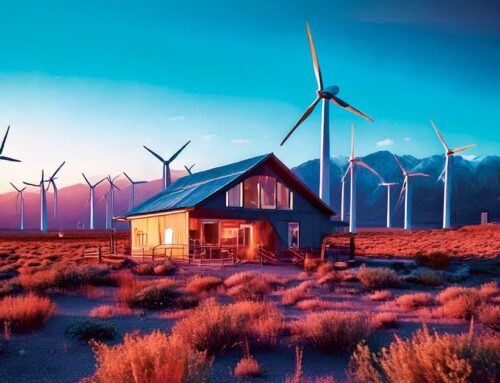Solar Power’s Glow-Up
October 23, 2024
Last month, an energy think tank released some rare good news for the climate: The world is on track to install 29 percent more solar capacity this year than it did the year before, according to a report from Ember. “In a single year, in a single technology, we’re providing as much new electricity as the entirety of global growth the year before,” Kingsmill Bond, a senior energy strategist at RMI, a clean-energy nonprofit, told me. A decade or two ago, analysts “did not imagine in their wildest dreams that solar by the middle of the 2020s would already be supplying all of the growth of global electricity demand,” he said. Yet here we are.
In the United States, solar accounted for more than half of all new power last year. But the most dramatic growth is happening overseas. The latest global report from the International Energy Agency (IEA) notes that solar is on track to overtake all other forms of energy by 2033. The world’s use of fossil fuels is already plateauing (the U.S., for its part, hit its peak demand for fossil-fuel energy way back in 2007). Energy demand is still rising, but renewables are stepping in to make up the difference. “The really interesting debate now,” Bond said, “is actually: When do we push fossil fuels off the plateau? And from our numbers, if solar keeps on growing this way, it’s going to be off the plateau by the end of this decade.”
The advantages of solar speak for themselves. Solar can be built faster and with fewer permits than other forms of energy infrastructure, mostly because the panels are flat and modular (unlike, say, a towering wind turbine or a hulking gas-fired power plant). It’s also adaptable at any scale, from an individual erecting a single panel to a utility company assembling a solar farm. And now, thanks to remarkable drops in prices for solar panels, mainly from China, simple market forces seem to be driving an all-out solar boom. “This is unstoppable,” Heymi Bahar, a senior energy analyst at the IEA, told me.
Globally, some 40 percent of solar’s growth is in the form of people powering their own homes and businesses, Bahar said. Perhaps nowhere is this better illustrated than in Africa, where Joel Nana, a project manager at Sustainable Energy Africa in Cape Town, has been leading an effort to help countries regulate and integrate the explosion of small-scale solar. When Nana and his team started quantifying just how much new solar was around, “we were actually shocked,” he told me. In South Africa, for example, the total amount of energy produced from solar systems in 2019 was thought to be about 500 megawatts, Nana said. But in the first quarter of 2023, when researchers used satellite imagery to count all of the solar installations in the country, they estimated that solar was producing a combined 5,700 megawatts of energy—only 55 percent of which had been declared to the government. That story of rapid, invisible growth is being repeated across the continent. Kenya now has about 200 megawatts of rooftop solar installed, representing 9 percent of the country’s total energy use, Nana said. Namibia has about 96 megawatts of rooftop solar capacity in its system, he said—a whopping 15 percent of its energy mix. “It’s been happening for three or four years, maybe five years, completely off the radar,” Nana said.
Solar seems to have passed a tipping point: In many countries, the low cost of the technology is propelling its own growth, despite little government help. In South Africa, businesses such as shopping malls and factories have historically run diesel generators to deal with frequent power outages. Many still do, but now others are saving money by installing solar panels. Electricity from a diesel generator costs about 10 rand per kilowatt-hour, Nana said; with solar panels, it plummets to about two rand. “It’s literally a no-brainer for a business owner,” he said. Businesses make up 80 percent of small-scale solar capacity in the country, according to his research. Soon, Nana hopes, arrays and batteries will become cheap enough that more homeowners across the continent will be able to afford switching to solar. And, as the journalist Bill McKibben has reported, some homeowners in African countries who have never been connected to the grid are getting electricity for the very first time via solar-panel kits, skipping over a fossil-fuel phase entirely.
Across the global South, solar is capturing unprecedented portions of the energy market. Pakistan, for example, imported the equivalent of a quarter of its total energy capacity in Chinese solar panels in just the first six months of this year. Many countries in the global South lack significant fossil-fuel resources, and importing them is expensive. “By far the easiest way to obtain economic growth in a country with a lot of sunshine and no fossil fuels is by exploiting your own domestic resources,” Bond said. Already, in countries including Brazil, Morocco, Mexico, and Uruguay, solar and wind make up a bigger share of electricity generation than it does in global-North countries. By 2030, RMI predicts, the global South will have quadrupled its solar and wind capacity.
That estimate doesn’t account for China, which is experiencing an unparalleled solar boom. In addition to supplying the rest of the world with panels, China installed more than half of the planet’s new solar capacity within its own borders in 2023, and the Ember report says it’s on track to add a similar amount this year. In 2023, the country more than doubled its own solar capacity year over year. “Nobody was expecting that it would be so high,” Bahar said.
Last year, at the United Nations Climate Change Conference, or COP28, in Dubai, 132 countries and the European Union pledged to triple the world’s renewable-energy capacity by 2030. According to Bahar, it’s the only promise of the many made in Dubai that’s likely to even be close to fulfilled: The world is on track to add 2.7 times its renewable capacity by then, and 80 percent of that increase will come from solar. To make use of all this growth, the world will have to add much more storage and transmission capacity, neither of which are keeping up with solar’s pace. The IEA, where Bahar works, will advocate for new pledges on those two fronts at COP29 next month. A world that mostly runs on solar power will also need something else—such as hydropower, nuclear, or geothermal—to generate energy when the sun isn’t shining in the evenings and winters. Jessika Trancik, an MIT professor who models clean-energy development, told me that governments need to steer investments toward storage and alternate forms of energy to compensate for that inherent downtime. That way, the world can have a reliable energy mix when 50 or 60 percent of electricity generation comes from solar and wind. That may seem far off, she said—solar made up about 5.5 percent of global energy in 2023—but with the exponential growth of cheap solar, “before you know it, it’s upon you.”
For Africa’s quiet solar boom to meet its full potential, governments will need to regulate and subsidize the technology, Nana said. Federal departments in Namibia, Kenya, and Eswatini have largely ignored the ascendance of solar technology within their borders, Nana said. Yet in South Africa, he’s seeing bright spots. Last year, the government began providing subsidies for solar for the first time. This year, its updated energy plan acknowledged that small-scale solar will be the biggest player in the country in the next decade. If South Africa is any indication, a solar revolution will arrive in more countries in the coming years. It may even sneak up on them.
Search
RECENT PRESS RELEASES
Related Post



